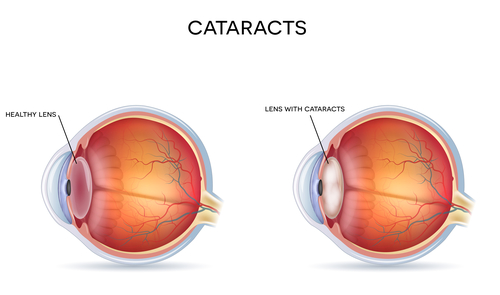Canine Cushing’s disease, also known as hypercortisolism and hyperadrenocorticism, is one of the most common hormonal diseases in dogs. Although not exactly the same, the terms Cushing’s disease and Cushing’s syndrome are generally used interchangeably.
There are actually 3 possible causes for this disease, and the symptoms for all three are the same. The difference lies in the treatment for each, so it is important to determine why your dog has Cushing’s.

If you have a puppy, your dog probably does not have Cushing’s disease. However, if you have a middle aged or older dog, your dog could develop Cushing’s. It is not hereditary, but some dog breeds are more likely to develop it than others.
Incidentally, Cushing’s is not limited to dogs. People, cats and horses also get Cushing’s disease.
What is Cushing’s Disease in Dogs?
If your dog has Cushing’s, his adrenal glands are producing too much cortisol or cortisone. This is a serious condition and can be life threatening. Too much cortisol weakens your dog’s immune system, leaving her open to infections and other canine diseases.
There are three types of Cushing’s found in dogs. Your vet will try to determine which type your dog has, as each type requires a different treatment.
Pituitary Gland Tumor
This is the most common form. In fact, 80-90% of dogs who have Cushing’s have this form of the disease. Primary Dependent Cushing’s is caused by a tumor on the pituitary gland, which is a pea sized gland at the base of the brain.
A pituitary tumor can be microscopic or quite large. Your dog’s symptoms will vary, depending on the size of the pituitary tumor. For example, a tiny tumor may not cause any symptoms at all, while a larger one will cause symptoms that will require a visit to the vet’s. If a pituitary gland is discovered early, your dog can live for many years, with medication. However, if the tumor enlarges, it will affect the brain and your dog’s life expectancy is shorter.
Adrenal Gland Tumor
A tumor on your dog’s adrenal gland can be benign or malignant. If the tumor is benign, a vet may be able to surgically remove it. Removing the tumor extends a dog’s life significantly. If it is cancerous or malignant, it can be removed, but the outlook for your dog’s life expectancy is not nearly as good.
Iatronic Cushing’s Disease
This type of Cushing’s occurs when a dog has been taking steroids, either by mouth or injection. Your dog could be taking steroids because of allergies, arthritis, or immune system disorders.
At some point, a dog’s system has had too many steroids and it reacts negatively. It is important to note that this only happens when a dog has taken steroids for a long time or he has taken an excessive amount of them.
Even if you suspect Cushing’s, it is important that you don’t take your dog off steroids abruptly. This can actually cause an “Addison’s disease crisis”, where your dog’s cortisol level drops too low–which is life threatening. Weening your dog off steroids should only be done with the advice of your vet. Signs of Addison’s include vomiting, diarrhea, listlessness, and loss of appetite.
Breeds Most Likely to Get Canine Cushing’s Disease
Although any dog can develop Cushing’s, some breeds are more prone to Cushing’s disease than others. Your vet is more likely to suspect Cushing’s if you have one of these breeds:
- Australian shepherds
- Beagles
- Boston terriers
- Boxers
- Cocker spaniels
- Dachshunds
- German shepherds
- Golden retrievers
- Labrador retrievers
- Maltese bichon
- Miniature poodles
- Staffordshire terriers
- Toy poodles
- Yorkshire terriers
Diagnosing Cushing’s in Dogs
Of course, as a pet owner, you are anxious to know what is causing your dog’s symptoms. But diagnosing Cushing’s can be difficult. Often laboratory test results are inconclusive or they give false positives for dogs that have another disease. Your vet may recommend retesting 3-6 months later to make sure you have the right diagnosis.
The two most common tests to detect Cushing’s disease are the ACTH stimulation test and the low-dose dexamethasone suppression (LDDS) test.
In addition, once you have confirmed that your dog has Cushing’s, your vet will probably suggest additional tests to determine exactly which type of Cushing’s your dog has. This is important because each type is treated differently.
In addition to blood work, your vet might suggest one or more of the following tests that will help determine the size and location of a tumor:
- Abdominal x-rays
- Ultrasound
- CT scan (computed tomography)
- MRI scan
Unless you have pet insurance, the costs for these tests can be quite high. A less expensive approach would be to try to balance your dog’s hormones with Dr. Mercola’s Adrenal Balance formula.
Diseases Often Confused with Canine Cushing’s Disease
Dogs with Cushing’s can have many different symptoms. Some have just a few and others have many. Because of this, the disease is hard to diagnose and it is often mistaken for other conditions in dogs.
In fact, canine Cushing’s disease is known in veterinary circles as “The Great Pretender”. That’s because it is really hard to diagnose and because it often looks like other canine diseases. Here are several dog illnesses that can mimic Cushing’s or vice versa.
Diabetes Mellitus
Diabetes and Cushing’s share many of the same symptoms (increased drinking, urination, and appetite, lethargy, and an enlarged liver).
Uncontrolled diabetes can lead to complications that, in turn, cause increased cortisol levels and symptoms that are identical to Cushing’s disease.
Testing and diagnosis of Cushing’s in a non-diabetic dog is complicated, but it gets even more complicated in a dog that has diabetes.
If your dog has diabetes that is not under control, the situation is even worse. This is because dogs with Cushing’s have similar blood panel abnormalities and blood chemistry abnormalities to dogs with uncontrolled diabetes. So, if your dog has both conditions, it becomes quite complicated.
Hypothyroidism
Hypothyroidism can be caused by a tumor of the pituitary gland. If your dog has this condition, she will be lethargic (low energy), unwilling or unable to exercise and will usually gain weight. With this condition, your dog may lose hair and have dry skin and hyperpigmentation of the skin.
Hyperthyroidism
In this case, your dog may have an increased appetite, excessive thirst and pee more frequently. You might also notice that she is get over excited, vomits, has diarrhea, and gets short of breath easily.
Brain tumor
Yet another condition that can mimic Cushing’s is a brain tumor. Symptoms that are similar to Cushing’s include difficulty jumping and climbing, falls, excessive thirst and seizures.
Prognosis for Dogs with Cushing’s Disease
Canine Cushing’s disease of the pituitary is not curable. But, with proper intervention, you can control the disease for years if your dog has a small pituitary tumor. If the tumor is large and affects the brain, the prognosis is less favorable. In addition, dogs who have neurological symptoms due to a pituitary tumor, will usually die sooner than others.
With a benign (not cancer) adrenal tumor, surgery (while costly) can usually correct the problem. However, if your dog has a malignant adrenal tumor, his prognosis is guarded to poor.
Unfortunately dogs with Cushing’s develop blood clots more than other dogs. Because of this, they can have a heart attack or stroke.
In the end, the average life span for a dog diagnosed with Cushing’s is two years. Only about 10% of dogs with Cushing’s live for 4 more years.
Cushing’s is most often diagnosed in geriatric dogs who are 7-12 years old. Statistically, most older dogs die of age-related causes, not related to Cushing’s.
If you are interested in learning more about Cushing’s and how to help your dog, a good source is Cushing’s Disease in Dogs by S. Kenrose and Merliza Cabriles DVM.







Leave a Reply